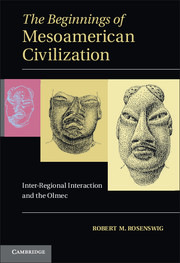Book contents
- Frontmatter
- Contents
- Figures
- Tables
- Acknowledgments
- SECTION I AN EARLY FORMATIVE MESOAMERICAN PROBLEM
- 1 Introduction
- 2 Knowledge in an Archipelago of Complexity
- 3 Mesoamerica's First Style Horizons and the “Olmec Problem”
- SECTION II ARCHAEOLOGICAL DATA
- SECTION III DERIVING MEANING FROM THE ARCHAEOLOGICAL RECORD
- 9 Conclusion
- Appendix 1 Temporally secure excavation contexts at Cuauhtémoc with detailed ceramic data
- Appendix 2 Temporally secure excavation contexts at Cuauhtémoc without detailed ceramic data
- References Cited
- Index
3 - Mesoamerica's First Style Horizons and the “Olmec Problem”
Published online by Cambridge University Press: 26 February 2010
- Frontmatter
- Contents
- Figures
- Tables
- Acknowledgments
- SECTION I AN EARLY FORMATIVE MESOAMERICAN PROBLEM
- 1 Introduction
- 2 Knowledge in an Archipelago of Complexity
- 3 Mesoamerica's First Style Horizons and the “Olmec Problem”
- SECTION II ARCHAEOLOGICAL DATA
- SECTION III DERIVING MEANING FROM THE ARCHAEOLOGICAL RECORD
- 9 Conclusion
- Appendix 1 Temporally secure excavation contexts at Cuauhtémoc with detailed ceramic data
- Appendix 2 Temporally secure excavation contexts at Cuauhtémoc without detailed ceramic data
- References Cited
- Index
Summary
We seem to have reached a watershed in Olmec studies – the disintegration of a traditional perspective and a realignment into a series of alternative interpretations.
Demarest 1989: 303This chapter provides the regional culture history for the Gulf Coast and Soconusco as well as expectations for the inter-regional relationship between the elites in the two regions. I begin by defining four epochs (i.e., temporal periods that can contain more than one ceramic phase) that make up Mesoamerica's Early and Middle Formative periods: an Initial Ceramic Period and three subsequent style horizons. Sketches of Soconusco and the Gulf Coast culture history are provided for each of these periods. I then review the “Olmec Problem” in Formative Mesoamerican studies (Pool 2007: 15–17, 197). That is, how do we understand the occupants of Mexico's Gulf Coast, particularly those inhabiting San Lorenzo during the second part of the Early Formative period? Furthermore, what is their relationship with the inhabitants of other regions? In the context of this book, I limit discussion as much as possible to the impact of changes occurring on the Gulf Coast to developments of the inhabitants across the Soconusco. My focus on these two regions is admittedly a bit myopic but necessary to provide a sufficiently detailed treatment of the data used to evaluate the competing hypotheses I present in this book. I then outline three competing models that describe Soconusco–Gulf Coast interaction.
- Type
- Chapter
- Information
- The Beginnings of Mesoamerican CivilizationInter-Regional Interaction and the Olmec, pp. 47 - 102Publisher: Cambridge University PressPrint publication year: 2009



